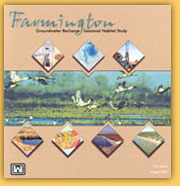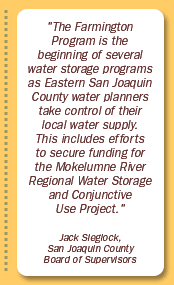 |
 |
 |
|
 The
Farmington Groundwater Recharge Program was launched in 2003 and
is the result of prior efforts to analyze and evaluate opportunities
for development of water supplies for Eastern San Joaquin County. The
Farmington Groundwater Recharge Program was launched in 2003 and
is the result of prior efforts to analyze and evaluate opportunities
for development of water supplies for Eastern San Joaquin County.
The precursor to the Farmington Program was the Farmington Groundwater Recharge and Seasonal Habitat Study. Completed in 2001, this feasibility-level study was developed to determine the potential for development of integrated groundwater recharge and seasonal habitat improvements in Eastern San Joaquin County. Conclusions of the study became the outline for the first phase of the Farmington Program, which includes implementing the flooded-field groundwater recharge technique on up to 1,200 acres for an average water recharge of approximately 35,000 acre-feet per year. The feasibility study followed the Farmington Dam and Reservoir Conjunctive Use Study. Completed in 1998, the Conjunctive Use Study evaluated potential structural and operation changes Farmington Dam and found that long-term storage at Farmington Reservoir does not appear to be cost effective; however, operations modifications to Farmington Dam and construction of groundwater recharge facilities does appear cost effective. The Conjunctive Use Study recommended that the feasibility of groundwater recharge with integrated seasonal waterfowl habitat areas in eastern San Joaquin County be evaluated. The Conjunctive Use Study followed the October 1996 update to the 1990 California Water Plan, a document of the California Department of Water Resources to review, analyze and provide recommendations for managing and long-term planning of the states water supply. At that time, authors noted that groundwater basins in the San Joaquin River region were in overdraft and predicted that without action continued use would exacerbate the situation. This overdraft contributed to an estimate that by 2020, without additional facilities and improved water management, state-wide annual shortages of 3.7 to 5.7 million acre feet would occur during average years. (Note: In its 1990 report, authors noted that the annual groundwater overdraft in San Joaquin County was 70,000 acre-feet/year. The 2003 update to the 2000 California Water Plan lists overdraft to Eastern San Joaquin County at 113,000 af/year.) Acting on this, and other information, Stockton East Water District (SEWD) took a lead role working with the U.S. Army Corps of Engineers (Corps) to develop a conjunctive use strategy for Eastern San Joaquin County. Members of the study management team and executive coordinating committee included SEWD, the Corps, the Central San Joaquin Water Conservation District, the North San Joaquin County Water Conservation District, City of Stockton, San Joaquin County, and CAL-Water Service Company. Program milestones included:
For more information about the Farmington Groundwater Recharge and Seasonal Habitat Study, visit: http://www.spk.usace.army.mil/Missions/CivilWorks/Farmington.aspx |
 |